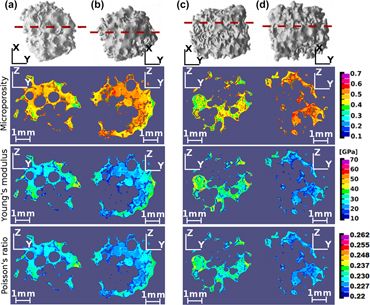Crossref Citations
This article has been cited by the following publications. This list is generated based on data provided by
Crossref.
Lee, Mun-Hwan
You, Changkook
and
Kim, Kyo-Han
2015.
Combined Effect of a Microporous Layer and Type I Collagen Coating on a Biphasic Calcium Phosphate Scaffold for Bone Tissue Engineering.
Materials,
Vol. 8,
Issue. 3,
p.
1150.
Hasslinger, Patricia
Vass, Viktoria
Dejaco, Alexander
Blanchard, Romane
Örlygsson, Gissur
Gargiulo, Paolo
and
Hellmich, Christian
2016.
Coupling multiscale X-ray physics and micromechanics for bone tissue composition and elasticity determination from micro-CT data, by example of femora from OVX and sham rats.
International Journal for Computational Methods in Engineering Science and Mechanics,
Vol. 17,
Issue. 3,
p.
222.
Scheiner, Stefan
Komlev, Vladimir S.
Gurin, Alexey N.
and
Hellmich, Christian
2016.
Multiscale Mathematical Modeling in Dental Tissue Engineering: Toward Computer-Aided Design of a Regenerative System Based on Hydroxyapatite Granules, Focussing on Early and Mid-Term Stiffness Recovery.
Frontiers in Physiology,
Vol. 7,
Issue. ,
Scheiner, Stefan
Komlev, Vladimir S.
and
Hellmich, Christian
2016.
Strength increase during ceramic biomaterial-induced bone regeneration: a micromechanical study.
International Journal of Fracture,
Vol. 202,
Issue. 2,
p.
217.
Blanchard, Romane
Morin, Claire
Malandrino, Andrea
Vella, Alain
Sant, Zdenka
and
Hellmich, Christian
2016.
Patient‐specific fracture risk assessment of vertebrae: A multiscale approach coupling X‐ray physics and continuum micromechanics.
International Journal for Numerical Methods in Biomedical Engineering,
Vol. 32,
Issue. 9,
Scheiner, Stefan
and
Hellmich, Christian
2017.
Advances in Ceramic Biomaterials.
p.
391.
Kariem, Hawraa
Hellmich, Christian
Kiefer, Thomas
Jäger, Andreas
and
Füssl, Josef
2018.
Micro-CT-based identification of double porosity in fired clay ceramics.
Journal of Materials Science,
Vol. 53,
Issue. 13,
p.
9411.
Scheiner, Stefan
Komlev, Vladimir S.
and
Hellmich, Christian
2018.
3D Printing and Biofabrication.
p.
1.
Scheiner, Stefan
Komlev, Vladimir S.
and
Hellmich, Christian
2018.
3D Printing and Biofabrication.
p.
107.
Elkhoury, Jean E.
Shankar, Raji
and
Ramakrishnan, T. S.
2019.
Resolution and Limitations of X-Ray Micro-CT with Applications to Sandstones and Limestones.
Transport in Porous Media,
Vol. 129,
Issue. 1,
p.
413.
Szlazak, Karol
Vass, Viktoria
Hasslinger, Patricia
Jaroszewicz, Jakub
Dejaco, Alexander
Idaszek, Joanna
Scheiner, Stefan
Hellmich, Christian
and
Swieszkowski, Wojciech
2019.
X-ray physics-based CT-to-composition conversion applied to a tissue engineering scaffold, enabling multiscale simulation of its elastic behavior.
Materials Science and Engineering: C,
Vol. 95,
Issue. ,
p.
389.
Zelaya-Lainez, Luis
Kariem, Hawraa
Nischkauer, Winfried
Limbeck, Andreas
and
Hellmich, Christian
2020.
“Variances” and “in-variances” in hierarchical porosity and composition, across femoral tissues from cow, horse, ostrich, emu, pig, rabbit, and frog.
Materials Science and Engineering: C,
Vol. 117,
Issue. ,
p.
111234.
Pang, Le
Paxton, Naomi C.
Ren, Jiongyu
Liu, Fan
Zhan, Haifei
Woodruff, Maria A.
Bo, Arixin
and
Gu, Yuantong
2020.
Development of Mechanically Enhanced Polycaprolactone Composites by a Functionalized Titanate Nanofiller for Melt Electrowriting in 3D Printing.
ACS Applied Materials & Interfaces,
Vol. 12,
Issue. 42,
p.
47993.
Buchner, Thomas
Kiefer, Thomas
Zelaya-Lainez, Luis
Gaggl, Wolfgang
Konegger, Thomas
and
Füssl, Josef
2021.
A multitechnique, quantitative characterization of the pore space of fired bricks made of five clayey raw materials used in European brick industry.
Applied Clay Science,
Vol. 200,
Issue. ,
p.
105884.
Scheiner, Stefan
2021.
Encyclopedia of Materials: Technical Ceramics and Glasses.
p.
750.
Zhuang, Li
Shin, Hyu-Soung
Yeom, Sun
Pham, Chuyen Ngoc
and
Kim, Young-Jae
2022.
A novel method for estimating subresolution porosity from CT images and its application to homogeneity evaluation of porous media.
Scientific Reports,
Vol. 12,
Issue. 1,
Hellmich, Christian
Ukaj, Niketa
Smeets, Bart
van Oosterwyck, Hans
Filipovic, Nenad
Zelaya-Lainez, Luis
Kalliauer, Johannes
and
Scheiner, Stefan
2022.
Hierarchical Biomechanics: Concepts, Bone as Prominent Example, and Perspectives Beyond.
Applied Mechanics Reviews,
Vol. 74,
Issue. 3,
Hellmich, Christian
Pircher, Lukas
Zelaya-Lainez, Luis
Vulović, Aleksandra
Filipović, Nenad
Grünewald, Tilman
Lichtenegger, Helga
and
Scheiner, Stefan
2024.
Bioimaging in Tissue Engineering and Regeneration.
p.
1.



